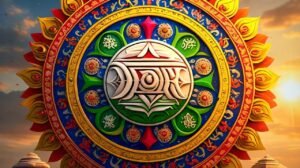The Indian flag, a symbol aptly incorporated in the Indica, is a color of saffron, white, and green with a navy-blue Ashoka Chakra accustomed at the center. The Ashoka Chakra or ‘Dharma Chakra’ symbolizes the wheel of law and/or the wheel of righteousness which has deep philosophical and cultural values in Indian society.
You Can Also Read This Girls And Boy’s Names Meaning Silver

HISTORICAL SIGNIFICANCE
The Ashoka Chakra in some way dates back to the Maurya Dynasty which was headed by Emperor Ashoka in the 3rd century BCE. Subsequently, Emperor Ashoka used the Dharma Chakra as his emblem of righteousness, which symbolized Buddha’s teachings and the word dharma meaning duty. The Chakra is a representation of the wheel of the law or the Dharma which signifies the continuous revolution, progression, and continuous cycle of existence.
SYMBOLISM IN MODERN INDIA
The social awakening of India and the hoisting of the national flag on August 15, 1947, for the first time, had the Ashoka Chakra in the middle. The design was adopted by the Constituent Assembly of India on July 22, 1947, to embed it with the country’s foundational principles and vision. Of the twenty-four spokes of the Chakra, it is explained that they depict twenty-four hours of each day and thus these principles do not have a beginning or an end.
10 STEPS TO KNOW THE SIGNIFICANCE OF THE INDIAN FLAG
Identify the Design:
by India is a vertical tricolor with three horizontal bands of saffron, white, and green and a navy blue Ashoka Chakra (wheel) in the center.
Understand the Colors:
- Saffron: Symbolizes heroism and selflessness.
- White: Represents all that is good including truth, peace, and purity.
- Green: Means faith and/or chivalry.
Learn about the Ashoka Chakra:
The 24 spokes wheel (Ashoka Chakra) in navy blue symbolizes the wheel of law or the turning wheel of Dharma.
Explore Historical Context:
The design of the flag was officially accepted on July 22, 1947 The flag was designed by Pingali Venkayya.
Understand the Concept of Dharma:
The Ashoka Chakra symbolizes the idea of Dharma, the concept of righteousness, duty, and moral order in taxation as described in ancient Indian philosophy.
Connect with National Identity:
It is important to note that the Indians take pride in the flag and Indians all over the world identify with it largely.
Study the Flag Code:
Try to get through with the rules and regulations given in the Flag Code of India which deals with the aspects of usage of the national flag.
Acknowledge Historical Significance:
Examine the place and significance of the flag during the campaign for India’s freedom and after gaining the freedom it was used that represented sovereignty.
Understand Contemporary Use:
Find out how the flag is employed from ceremonial occasions right through the national holidays up to the international forums.

Reflect on Personal Significance:
Think about the concept of the flag and how you are touched by the spirit and meaning of the Indian nation.
DESIGN AND MEANING
- The Ashoka Chakra looks rather accurate and flawless, with twenty-four spokes being evenly separated one from the other. Thus the Chakra navy blue color symbolizes the sky and ocean for the vastness depth and inclusion of Indian culture. Its position in the middle of the flag is not arbitrary, as the guidance of the constitution is a principal virtue of the country.
CULTURAL IMPACT
- Apart from being associated with the political realms of government and involvement in state affairs, Dharma Chakra has religious and historical values for the Indian populace.
- It is a pointer to the nation’s philosophical tradition of its policy to embrace practices and standards of truth, justice, and morality. The Chakra’s presence on the flag is a visual affirmation of India’s secular and pluralistic ethos, reflecting its commitment to unity amidst diversity.
EDUCATIONAL INSIGHTS
Understanding the Ashoka Chakra encourages deeper exploration into Indian history, philosophy, and governance. It provides a gateway for students and scholars alike to delve into the teachings of Emperor Ashoka, the development of Buddhism, and the evolution of India’s cultural identity. Educators can utilize the Chakra as a teaching tool to foster discussions on ethics, morality, and the role of symbols in shaping national identity.

CONCLUSION
The Ashoka Chakra on India’s national flag is more than just a symbol; it is a representation of the nation’s ethos, history, and aspirations. Its design and meaning offer profound insights into India’s cultural and philosophical heritage, making it an invaluable educational resource. By exploring the significance of the Dharma Chakra, individuals gain a deeper appreciation for the principles that unite and define the nation of India.
In essence, the Ashoka Chakra serves as a timeless beacon, guiding India on its path towards progress, unity, and harmony.
Explore This Nicknames for Charles










